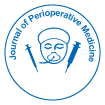
Journal of Perioperative Medicine
Open Access
ISSN: 2684-1290

ISSN: 2684-1290
Perspective - (2025)Volume 8, Issue 1
Ambulatory surgery, also known as outpatient or day surgery, has become an integral component of modern healthcare systems, especially in high income countries where advances in surgical techniques and aesthetic management have enabled patients to undergo procedures safely without overnight hospitalization. A critical aspect of ambulatory surgery is the choice of anaesthesia, which directly influences patient recovery, complication rates and overall satisfaction. Regional Anaesthesia (RA) and General Anaesthesia (GA) are the two primary aesthetic techniques used, each with distinct advantages and challenges. Understanding their comparative benefits and limitations in the ambulatory setting is essential for optimizing perioperative care and patient outcomes.
Regional anaesthesia refers to the targeted blockade of nerve impulses to specific body regions, typically achieved through spinal, epidural or peripheral nerve blocks. General anaesthesia, in contrast, induces a reversible state of unconsciousness and amnesia, generally using intravenous and inhalational agents. Both modalities are widely employed in ambulatory surgeries, but the choice often depends on multiple factors including surgical site, patient comorbidities, expected duration of surgery and institutional protocols.
One of the most significant advantages of regional anaesthesia in ambulatory surgeries is the potential for superior postoperative pain control. By selectively blocking nociceptive pathways, RA minimizes the need for systemic opioids, thereby reducing opioid related adverse effects such as nausea, vomiting, respiratory depression and sedation. This improved analgesia facilitates faster recovery, earlier mobilization and greater patient comfort—all important for successful same day discharge. Numerous studies from institutions in the United States and Europe have demonstrated that patients receiving RA report lower pain scores and decreased opioid consumption in the immediate postoperative period compared to those who undergo GA.
Additionally, regional anaesthesia has been associated with lower incidences of Postoperative Nausea and Vomiting (PONV), a common cause of delayed discharge and patient dissatisfaction in ambulatory settings. By avoiding volatile anaesthetics and high doses of systemic opioids, RA decreases the risk of PONV, contributing to a smoother recovery phase. This factor alone has prompted many centres to prioritize RA techniques whenever feasible, especially in patients with a history of PONV or motion sickness.
From a safety perspective, RA reduces the risks associated with airway manipulation such as aspiration, bronchospasm, or difficult intubation, which can be particularly beneficial in patients with respiratory comorbidities. Furthermore, the use of RA may avoid the hemodynamic fluctuations often seen during induction and emergence from GA, promoting cardiovascular stability in vulnerable patients.
However, regional anaesthesia is not without limitations. The requirement for technical expertise, potential for nerve injury or hematoma and rare but serious complications such as Local Aesthetic Systemic Toxicity (LAST) necessitate skilled providers and careful patient selection. Moreover, the onset time for RA can be longer compared to GA, potentially increasing turnover times in high-volume ambulatory centres.
General anaesthesia remains the predominant choice for many ambulatory procedures due to its versatility and rapid onset. It facilitates airway control, immobility and optimal surgical conditions, particularly in lengthy or complex surgeries. The availability of short acting anaesthetics and modern airway devices has significantly improved the safety profile of GA, enabling quick recovery and discharge in well selected patients.
Comparative data between RA and GA in ambulatory surgery suggest that while both techniques are generally safe and effective, RA offers distinct advantages in terms of pain management and recovery profiles. For example, studies from Canadian and UK surgical centres have reported shorter Post Anaesthesia Care Unit (PACU) stays and higher patient satisfaction scores in patients undergoing RA compared to GA. However, patient preferences, anxiety levels and comfort with being awake during surgery also influence aesthetic choice and satisfaction.
In practice, a hybrid approach is often employed. Many ambulatory procedures benefit from combined techniques such as Monitored Anaesthesia Care (MAC) supplemented by regional blocks, which optimize analgesia while maintaining patient comfort. This customised approach leverages the strengths of both anaesthesia types and exemplifies personalized perioperative care.
The economic implications of anaesthesia choice in ambulatory surgery are also noteworthy. Regional anaesthesia, by minimizing complications and enhancing recovery, has the potential to reduce healthcare costs associated with prolonged PACU stays, unplanned admissions and readmissions. In high income countries facing rising healthcare expenditures, optimizing aesthetic technique represents an opportunity to improve value based care.
Despite growing evidence favouring RA in many ambulatory settings, widespread adoption remains inconsistent. Barriers include provider familiarity, institutional protocols, equipment availability and logistical challenges in ensuring adequate postoperative monitoring for block-related side effects. Educational initiatives and interdisciplinary collaboration are critical to overcoming these challenges and integrating RA more broadly into ambulatory surgical care pathways.
The choice between regional and general anaesthesia in ambulatory surgery significantly impacts patient outcomes, recovery trajectories and healthcare efficiency. Regional anaesthesia offers notable advantages in pain control, reduced opioid use and lower incidence of postoperative nausea, contributing to faster recovery and improved patient satisfaction. General anaesthesia, meanwhile, maintains its role in complex procedures and patient populations where airway control and rapid induction are priorities.
In the evolving landscape of ambulatory surgery, a patientcentred approach that considers surgical factors, patient preferences and institutional resources is paramount. Increasing integration of regional anaesthesia techniques, supported by robust training and protocols, has the potential to enhance recovery and reduce complications in ambulatory settings. Ultimately, a nuanced understanding of the comparative benefits of RA and GA will empower clinicians to tailor aesthetic care, improving safety and outcomes in this rapidly expanding surgical domain.
Citation: Mitchell JE (2025). Comparative Study of Regional vs. General Anaesthesia in Ambulatory Surgeries. J Perioper Med. 8:265.
Received: 05-Feb-2025, Manuscript No. JPME-25-37975; Editor assigned: 07-Feb-2025, Pre QC No. JPME-25-37975 (PQ); Reviewed: 22-Feb-2025, QC No. JPME-25-37975; Revised: 02-Mar-2025, Manuscript No. JPME-25-37975 (R); Published: 09-Mar-2025 , DOI: 10.35248/2684-1290.25.8.265
Copyright: © 2025 Mitchell JE. This is an open-access article distributed under the terms of the Creative Commons Attribution License, which permits unrestricted use, distribution, and reproduction in any medium, provided the original author and source are credited.